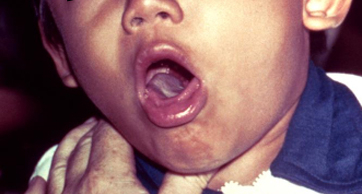Resumo
Definição
História e exame físico
Principais fatores diagnósticos
- hoarseness
- dysphagia
- sore throat
- odynophagia
- cough
- hyperemia of the oropharynx
- history of heavy vocal use
- gastroesophageal reflux
- oropharyngeal white-gray exudates
Outros fatores diagnósticos
- rhinitis
- fatigue and malaise
- fever
- enlarged tonsils
- enlarged, tender anterior cervical lymph nodes
- postnasal drip
- dyspnea
- weight loss
- tonsillopharyngeal exudate
- acute respiratory distress
- toxic appearance
- drooling
- stridor
Fatores de risco
- recent history of upper respiratory infection
- incomplete or absent Haemophilus influenzae type B (Hib) vaccination
- incomplete or absent diphtheria vaccination
- contact with infected individual
- travel to area where diphtheria or tuberculosis are endemic
- HIV or other immunocompromise
- use of inhaled corticosteroids or prolonged courses of antibiotics
- heavy vocal use
- tobacco use
Investigações diagnósticas
Primeiras investigações a serem solicitadas
- laryngoscopy
Tests to avoid
- computed tomography (CT)
- magnetic resonance imaging (MRI)
- viral panel testing
Investigações a serem consideradas
- biopsy
- oropharyngeal cultures
- nasal swab for culture
- serum immunoprecipitation or polymerase chain reaction for diphtheria
- complete blood count
- rapid antigen detection test
- chest x-ray
- sputum cultures
- videostroboscopy
Algoritmo de tratamento
with potential airway compromise
viral
suspected bacterial: nondiphtheria and nontuberculous
confirmed diphtheria
tuberculosis
fungal
vocal strain
Colaboradores
Autores
Vaninder Kaur Dhillon, MD
Assistant Professor
Johns Hopkins University
Otolaryngology-Head and Neck Surgery
Divisions of Laryngology and Endocrine Head and Neck Surgery
Bethesda
MD
Declarações
VKD declares that she has no competing interests.
Agradecimentos
Dr Vaninder Kaur Dhillon would like to gratefully acknowledge Dr Chad W. Whited, Dr Seth H. Dailey and Dr Ozlem E. Tulunay-Ugur, the previous contributors to this topic. CWW, SHD and OETU declare that they have no competing interests.
Revisores
Michael Johns, MD
Director
Assistant Professor
Emory University
Atlanta
GA
Declarações
MJ declares that he has no competing interests.
James Suen, MD
Chair; Professor
University of Arkansas for Medical Sciences
Department of Otolaryngology - Head and Neck Surgery
Little Rock
AR
Declarações
JS declares that he has no competing interests.
Remco de Bree, MD, PhD
Otolaryngologist
Head and Neck Surgeon
VU University Medical Center
Amsterdam
The Netherlands
Declarações
RdB declares that he has no competing interests.
Créditos aos pareceristas
Os tópicos do BMJ Best Practice são constantemente atualizados, seguindo os desenvolvimentos das evidências e das diretrizes. Os pareceristas aqui listados revisaram o conteúdo pelo menos uma vez durante a história do tópico.
Declarações
As afiliações e declarações dos pareceristas referem--se ao momento da revisão.
Referências
Principais artigos
House S A, Fisher E L. Hoarseness in adults. Am Fam Physician. 2017 Dec 1;96(11):720-8.Texto completo
Dworkin JP. Laryngitis: types, causes, and treatments. Otolaryngol Clin North Am. 2008 Apr;41(2):419-36. Resumo
Stachler RJ, Francis DO, Schwartz SR, et al. Clinical practice guideline: hoarseness (dysphonia) (update). Otolaryngol Head Neck Surg. 2018 Mar;158(1_suppl):S1-S42.Texto completo Resumo
Artigos de referência
Uma lista completa das fontes referenciadas neste tópico está disponível para os usuários com acesso total ao BMJ Best Practice.

Diagnósticos diferenciais
- Tonsillitis
- Infectious mononucleosis
- Allergic rhinitis
Mais Diagnósticos diferenciaisDiretrizes
- Clinical practice guideline: hoarseness (dysphonia)
- Sore throat (acute): antimicrobial prescribing
Mais DiretrizesPatient information
Sore throat
More Patient informationLog in or subscribe to access all of BMJ Best Practice
Use of this content is subject to our disclaimer